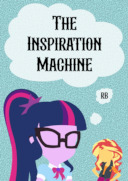The Chapter That Nearly Broke Me (RB Vs. Empress Theresa, Chapter 13) · 5:53pm May 2nd, 2021
Previously, on Empress Theresa:
North Korea North Korea'd. Theresa Theresa'd.
And now:
This is the big one, folks. Theresa's finally going to fix the wind thing. She's feeling very confident. So confident, in fact, that she invites her gracious hosts, the Parkers, to watch as she saves the world.
She does her thing. They watch, rapt, the television screens which display Theresa's creation in the arctic.
Kinda funny that they're doing this at the beginning of a chapter; this is usually the sort of thing that gets saved for the end—
Nothing happens.
What?
Nothing. Happens.
Theresa is as surprised as the rest of us that nothing's happened. In fact, she even gets a little whiney about it.
“I did everything correctly,” I claimed. “In this world perfection isn’t good enough.”
Not what you want to hear when the fate of the world is at stake.
Theresa postulates that HAL may be refusing to cooperate. Which is a thing he can do now. Apparently. Despite being a thoughtless ball of dark matter powered by reflex. Whatever.
They try again the next day. It works this time! Turns out HAL was just tired. What was the point of them failing the first time if they were going to succeed anyway with nothing in between? I dunno, ask Mr. Boutin.
Anyway, HAL raises fifty-six water columns into the air at the pole. Steve provides a theory as to where HAL is getting all this energy from: the sun. He also claims that the sun has... hurricanes... on it. All the time. Not sure what he's, uh, trying to get at, there, but that is decidedly not the case. Maybe Mr. Boutin meant solar storms? Who knows.
Anyway, HAL is Superman. That's the important part.
Moving on, Theresa and Steve decide to blow off some steam by taking a walk in the woods. Meanwhile, the water columns keep rising, far past their previous height of a thousand miles. At five thousand miles high, Theresa and her audience reconvene.
The water columns were actually ice columns. A hundred miles above the Earth there was only a trace of air molecules. The temperature was—actually, there was no temperature—because there was no matter to hold heat. Infrared radiation poured out of the columns. The water quickly froze solid.
So, this is wrong, actually. It may be true that gasses are sparse in the thermosphere, but it's not a perfect vacuum. There are plenty of other particles that can carry temperature in the thermosphere, like photons, and radiation! In fact, it's impossible in thermodynamics as we understand it for temperature not to exist, so... yeah! Science!
It is really friggin' cold up there, though. Well, kind of—actually the gasses that are there are really hot but at such a low density it makes it almost impossible for them to transfer heat, fun fact—but it's enough to freeze the water.
Also, another fun fact, the ISS is in the thermosphere, too, at a height of about 255 miles, meaning that Theresa's water/ice columns tower over it. Good thing it doesn't orbit over the arctic. Too bad about any low Earth orbiting satellites that happen to cross paths with the pole, though (altitude between 99 and 1243 miles above sea level). Heck, anything in lower medium Earth orbit, too.
Anyway, once HAL stops providing support, the ice begins to break apart, and comes crashing down.
It then explodes.
No, I'm not kidding.
No really, I'm not kidding! Look:
A blinding flash whitened the television screen. There was only a whiteout to look at. It was a titanic explosion.
Steve quipped, “It’s not every day you see white hot water.”
I elbowed him in the ribs.
After fourteen seconds the white flash faded away to reveal a sixteen mile wide yellow ball. This ball expanded rapidly and gradually turned an intense crimson red.
Someone on a plane in the area said, “This is insane. It’s a hydrogen bomb exploding every second.”
Mr. Parker asked, “Is that true, Steve?”
“It’s about right. I calculated eight million tons of TNT every second.”
“Good Lord!”
I... I don't...
Could someone please... please... explain to me what just happened? Because I am at a goddamn loss. I've read this three times now and I still have no idea why this happened.
I just...
I need a minute.
Alright, I'm back.
So the water explodes, and—nope, sorry, need another minute.
Alright. So. The water explodes. That's a thing. That happens. It doesn't vaporize. It straight up explodes. Like an actual explosion. Giving off light and heat.
Except it's not just an explosion. It's a continuous explosion. Which Theresa finds novel.
Then the shockwave hits the planes that have been filming this thing. The shockwave is travelling at Mach 3. Somehow, the plane still makes it.
And then, well, this... happens:
The red blasting ball had increased to thirty miles in diameter at which point the matter cooled down to invisible infrared.
The what did what?
Soon, a new phenomenon began. White steam coalesced seemingly from nothing some miles from and around the bottom third of the red ball. These steam clouds fell at a steep angle to form what looked like a giant umbrella. Then as the steam reached lower altitudes, it diverted more horizontally to spread out over the ocean. This cloud blanket was very thick, and meteorologists predicted it would spread out for hundreds of miles.
Yaaaaaaaay. This, of course, hasn't solved the problem yet, but there's more, and, like...
Okay, so here's an idea. I know it's probably wrong, but bear with me for a minute.
As the ice hits the atmosphere, it is instantly heated to "thousands of degrees" (according to the book, just roll with it), and vaporizes. At high enough temperatures, water molecules can separate into hydrogen and oxygen. Hydrogen and oxygen are very flammable, especially at high temperatures. The two form an explosive mixture and ignite, causing the explosion we saw earlier. This reaction also forms water as a byproduct, putting moisture back into the atmosphere, which is spread by the explosion across the planet.
I genuinely do not know if this would actually work or not. It probably wouldn't! What I want to illustrate here, though, is that in all likelyhood, I just spent more time thinking this over than Mr. Boutin did. An explanation like this, even if only plausible at first glance or to a layperson, makes these events a lot easier to swallow for a reader. Of course, events that are backed by a solid understanding of the subject matter and plenty of research are preferable, but you see what I mean. It's better than nothing
As it is, there's almost no explanation for this in the text, and the small bit of this process that is explained mentions the hydrogen atoms losing their electrons for some reason and then forming water with oxygen in the atmosphere, so... yeah.
Anyway, the end result of all of this malarkey is a rainbow that can be observed over the entirety of the US and Europe. Five hours later, the rain starts. A quarter inch of rain a day, if the book is to be believed.
Theresa isn't done, though. She then—
Okay, I want you to guess what Theresa does next. The problem she's trying to solve is the famine, specifically in Asia. They won't have time to plant a new crop before the winter, and thus will have untold famines.
Guess how Theresa solves this one. Go on. I want to see your guess in the comments.
Done guessing?
Okay.
So Theresa solves this by changing the Earth's axis of rotation so that the entire planet will see summer weather year-round, thus allowing for three crops a year. She solves the problem of winter famines by getting rid of winter.
Consider the ecological ramifications of that one for a bit. Go on. Think about all the life on Earth that has evolved to cope with four seasons. Think about what this might do to the ice sheets. Hell, think about what this might do to the planet itself.
Theresa just doomed the world to ecological crisis. Forget climate change, Theresa just killed us all.
Well, if this was the real world she would have, anyway. As this is Mr. Boutin's fantasy world which totally isn't science fiction, and Theresa can do nothing wrong, everything will probably be okay.
“It will be done. Mrs. Hartley is trying to eliminate winter?”
“Yeah. She figures we don’t need it.”
Gooooooooood.
Anyway, that's the end of the chapter. Have fun. I'm going to go drink.
See you next time, folks.






I dunno, but I'm guessing it has to do with raising a column of water into the air.
Or spinning the earth backwards so it goes back in time. >:V HAL is Superman, after all.
Haha, wow, who the fuck would ever... Okay, Boutin would ever, that's who. Geez.
So, the water would freeze in the vacuum of space, but not by radiating its heat away. Radiation is actually a very slow process. The water would start boiling away due to the low pressure, carrying away heat in the process, and the main mass would freeze once it got cold enough.
Oh, and for the record, a free fall from 8,000 km would end with the ice chunks traveling at 12 km/s, hitting the atmosphere, maybe partially melting, and most likely shattering from the stress of reentry. While it would release a lot of energy into the atmosphere, it wouldn't be like an 8 MT nuke exploding every second, and it would have nothing to do with the water dissociating and then combusting.
Oh, and the planes? If they were close enough to feel a shockwave moving at Mach 3, they'd be toast. But you probably knew that already.